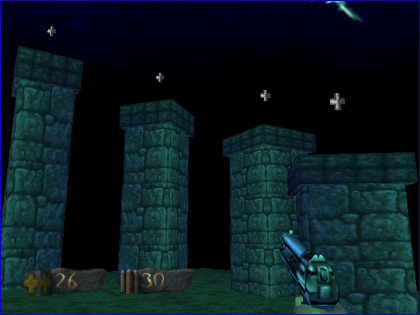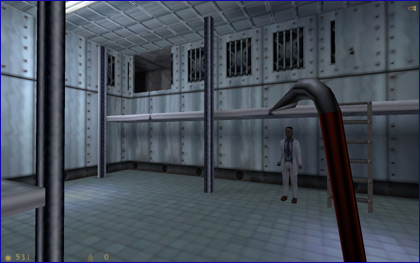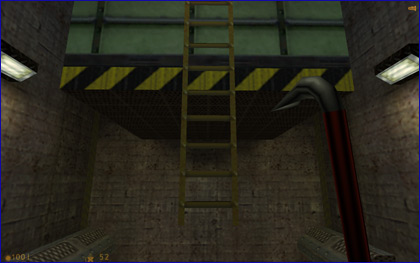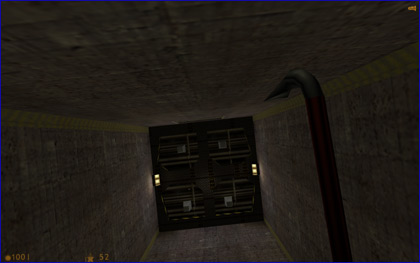This is a little bit of a follow-up to a post I made back on November 30th, but I have a lot more to add with a lot more detail. I originally called this post “Platforming In FPS Games” but I ended up talking about a significant amount more than just that subject, so I think it fits in with the “Video Game Club” idea much better. There aren’t any significant “spoilers” in what I’ve discussed here (especially since I’m still so early in the games), so there is no “behind-the-cut” to hit and read the rest of the entry.
I’m pretty sure I’ve mentioned this in the past, but I’m not the biggest fan of FPS games. After the obligatory Doom II and Duke Nuken 3D back in high school, I didn’t progress with the genre at all. Sure, I played a little Goldeneye 007 on Nintendo 64 like anyone else who owned the console, but not gaming on the PC at all (in arguably one of its “golden” eras), I simply never really had the chance to play them, and they never really entered my mind as something to even bother with.
I think it was the combination of seeing Bioshock, Team Fortress 2, and Portal in 2007 that swayed me a little bit. The first was all about an incredible atmosphere, the second was all about a hilarious aesthetic and class-based teamwork, and the third was all about humor and ingenuity. More than weapons, more than speed, more than the number of polygons, and more than anything else, those aspects made me take a second look at the genre.
I played through the demo of Bioshock (once on the 360, and even then again on the PC) and really enjoyed what I played. I picked it up on 360 sometime last year (and even just a couple weeks back for $5 on Steam… just to have it around) but haven’t gotten around to playing any more of it. I’ve dabbled here and there in Team Fortress 2, but the game is essentially unapproachable for general multiplayer action for anyone who isn’t already an FPS master. I’m sitting on my save at the last level in Portal, and loved every minute I have played in it (I’ll get around to beating it, I promise!).
Within the last month, I decided that before playing any more of these games (including the Half-Life 2 series of games, which I obtained via The Orange Box), I was going to dip a little back into the past and play a couple older games to see how the genre has evolved at least over the last ten years (if not longer). I had asked for the first Halo as a Christmas present last year, and it’s been sitting in my collection ever since. I picked up the first Half-Life on Steam a couple months back when they were running the special $1 sale on it to celebrate its 10-year anniversary. With these two in tow, the golden standards of PC- and console-based FPSing, I figured I would have a great and educated jumping ground.
The first thing I confirmed for myself (which I’ve mentioned before, but it bears repeating) was how much of snob I’ve become for mouse-and-keyboard FPSing, despite hardly caring about the genre at all. I played through a little bit of the demo for Portal: Still Alive on 360, and was immediately thrown off with the (by-comparison) clunkiness and slow response time. Andrew mentioned on the podcast recently how he played through the 360 version with absolutely no problem, but had never actually played (at least seriously) an FPS on the PC to really compare the controls. To come in with a total “n00b” perspective with absolutely zero pre-conceptions and honestly give all types of control schemes a chance, I can honestly say that given the opportunity, I would always pick mouse-and-keyboard over dual-sticks, and I have a hard time understanding why anyone would ever choose differently.
Let’s talk about the actual games, though.
Being so unfamiliar with and terrible at FPS games, and therefore multiplayer sessions being nothing more than an endless and frustrating cycle of spawn-kill, I really enjoyed being able to dive into the single-player campaign of Half-Life. I love stories, narrative, flow, etc., and so far it’s delivered on all fronts (note that I just finished “Office Complex”, the third “level”, last night). I understand that it’s a game from 10 years ago, so I’ve been able to forgive the quirky mannerisms of some of the NPCs (which actually makes them more endearing than I think they otherwise would be). I haven’t gotten too much of the “story” yet, but the flow it’s riding along with has been near-perfect so far. I’ve only seen one hint of the “G-man” (I know I’ve missed some), but it was wonderfully creepy and enthralling. I’d love to tell you more about it, but I really need to get further along in the game before I can say a lot more.
There is one part of the gameplay I’d like to slightly rant about, though, and it happens to be the original title of this column (before I ended up writing so much more than I anticipated): platforming in FPS games. I neglected to mention earlier that I played through a bit of the first Turok game on Nintendo 64, and this may have been one of the moments in FPS gaming that turned me off for a while. I personally have an incredibly difficult time “platforming” in first-person. By that I mostly mean precise jumping. Whether it was from little circular cliff to little circular cliff in Turok, or hanging box to hanging box in Half-Life, I have a horrible time doing it right. My sense of depth is completely thrown off, and I have almost zero “sense of self” with regards to my surroundings. I know a lot of readers/listeners wrote in to say that it’s something you get used to with time (which I can completely see happening), but as-of-yet, I am still suffering from the same plague.

Let me showcase two examples that drove me absolutely insane just within the “Office Complex” level. In this first example (the second-to-last area within “Office Complex”), you need to get up into that little vent/corridor, which will lead the way to hopping atop the moving conveyor, and ultimately across to the next section. I can’t describe or count the number of ways and times that I tried to get in there. I even pushed a giant box from one end of the level back to this room (all Zelda puzzle-solving style) just in case I need to jump from the ledge across from the vent up to the box and then up into the vent (needless to say, I didn’t need to do that). Despite the fact that I had been doing several running crouch-jumps towards that area, it never worked. Well, that’s not true. Eventually it worked. I have no idea what I did differently, but somehow I managed to squeeze myself up in there. I had actually not played the game in maybe a week or so because I was “stuck” in trying to get myself up in there, so it was quite a relief to not have to drop the game simply because I couldn’t control myself properly in level three.

That wasn’t the end of my frustration, though. Anyone who knows the game much better than I ever hope to will know exactly what came next.

That’s right. Climbing up ladders, jumping to other landings, jumping to more ladders, and getting to the top of an elevator was my next task. I amazingly only died once before I got to the last ladder (and that was my own fault for not paying full attention to the game). The last jump looks so incredibly easy, and should have been a piece of cake. However, this is probably the one spot where I died in the game more so than any other spot thus-far. Despite it being directly in front of me, I absolutely could not get myself to jump straight across and grab onto the ladder. I always seemed to end up too low, ladder completely within my sight but not my grasp, and then found myself plummeting to my death below. I stopped counting how many times I died, but I eventually grabbed onto it and finished the level.

This means that my experience with Half-Life so far has been complete enjoyment of the story/narrative, the characters, and even the enemies… with the major “fault” being one tiny element of the gameplay! Unfortunately, that one “fault” has been enough to frustrate me into not playing the game for at least one week’s period of time, and intimidate me from playing as much as I otherwise would probably want to.
Let’s leave behind Half-Life (except to make comparisons) and turn over to Halo, a game that came out three years later. Almost immediately upon starting the game, I could see just how much of a new groundwork Half-Life had laid for the genre with its scripted events and mostly-obvious level design choices to lead you in the right direction. While not as memorable as the monorail sequence that begins Half-Life, the beginning of Halo does many of the same things by introducing you to the game’s world, the basic control schemes, the important sub-characters, the enemies, and more. I especially liked the back-and-forth choice you are offered with regards to inverted or standard control with the right control stick; it crossed the fourth wall just barely enough to still make sense in-universe, but make you smile at the same time.
I have definitely played much less in Halo than I have in Half-Life (only about an hour or so, completing level two, “Halo”), so I do not yet have as much in-depth insight into my own gameplay as I will upon finishing a few more sessions with the game. To tangentially relate the discussion back to the original topic (being platforming in FPS games), the only “platforming” problem I have had so far was more in the vehicle usage than controlling Master Chief, himself. I had a very difficult time controlling the Warthog, especially when I would need to change directions. I felt as if it were almost driving too fast, giving me little in the way of response time. Yes, I flipped myself over countless times. Yes, I had to get out and punch the Warthog out of a corner so I could hop back in it (once accidentally exploding myself in the process). I think I will have an easier time controlling the vehicles in Halo than I will jumping around from box to box to ladder to ladder in Half-Life, but I suppose that remains to be seen.
It would be impossible to talk about the two games without mentioning the vast difference between each main character (Gordon Freeman and Master Chief, respectively). The “silent protagonist” shtick certainly isn’t something unfamiliar to me (having played plenty a Legend of Zelda title), and I have to admit I was pretty surprised when Master Chief actually spoke (albeit during cut-scenes), as opposed to Gordon who remains completely silent at all times. I don’t have much more to add to this part of the discussion just yet, as I feel I’m far too early in each game to do a fair comparison in that respect.
Those of you still waiting to hear about my experiences with Final Fantasy VI, fret not. I have continued into the game some more, and I will absolutely be delving into more thoughts and ponderings with it. Until then, let me know what you think about this particular topic, and what your experiences have been. I feel like I’m in a totally new world, and I look forward to (hopefully) finishing these two games and maybe even moving on to their sequels (eventually… remember, it’s taken me ten years to get to Half-Life).


This makes me want to go back and play Half-Life again. I really loved a lot of the narrative perks, especially the fact that this is the first time we see Valve’s infamous graffiti narrative (you’ll see it in a few levels) and the atmosphere just those words generate is chilling enough to increase the tension.
I totally agree on the short-comings of Half-Life. I was loving the game, but just got to a point in which the gameplay made it unbearable.
Fortunately, Half-Life 2 is nowhere near as difficult to play (you still have ladders and jumping and the like, but it’s no where near as obnoxious as in it’s predecessor), and the story and characters blow the original away.
I have The Orange Box on the 360, and have never really had any issues. I finished Portal just fine, and Half-Life 2 and it’s first episode were no sweat. I did experience some issues in Half-Life 2 Episode Two, however, but I think that has more to do with me sucking at first person shooters than the controls themselves.
And, since you mentioned it in passing, I’ll just say that I finished Bioshock just this afternoon, and that it may be my favorite 360 game I’ve played since I’ve gotten the system (weird ending and all).
You are me in terms of FPS about a year ago, not joking. Totally hated them, sucked at them, controls felt too hard to get used to, etcetera. But then I decided it was about time I destroyed my dislike of the genre, and did so with Portal. Since then, I’ve played through (almost game for game) just about everything you’ve talked about here. Halo, all of the Half-Life series (other than HL1 expansions, which feel archaic in comparison to the newer shooters I’ve played), the first Halo, and, finally, I just finished BioShock yesterday.
The one thing I can’t really agree with you on is keyboard and mouse controls. Maybe I’m just too comfortable with a controller, but I love console FPS far more than FPS on the PC.
Everyone struggles with the Warthog the first time around. It is power-slide-tastic like few video game vehicles are in these days of “realistic physics.” Learn to love the handbrake. After a while, I found myself forgoing a more logical or efficient tactic just for the sake of grinding some Covie’s face under my wheels.